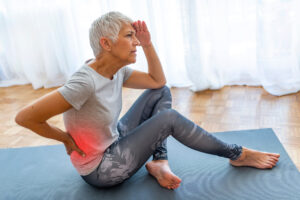 As we get older, our body starts to deteriorate. Part of that includes the fluid that is located in our disc. Losing this fluid means stiffness, which increases the risk of injury. Continue reading below for why we have more back pain after 50. If you think you need to consult a physician, click here to contact us and schedule an appointment.
As we get older, our body starts to deteriorate. Part of that includes the fluid that is located in our disc. Losing this fluid means stiffness, which increases the risk of injury. Continue reading below for why we have more back pain after 50. If you think you need to consult a physician, click here to contact us and schedule an appointment.
If an aching back is starting to feel more like a regular thing — and less like something you randomly pulled at the gym — well, you’re not alone. About 6 million older adults in the U.S. live with chronic lower back pain.
As we get older, we start to lose fluid in our discs, experts explain. As we lose fluid, the discs tend to collapse, we get stiffer, and the risk of injury becomes greater.
From there, plenty of lifestyle habits raise your risk. Some of these, like hoisting your grandkid or overdoing the gardening, are obvious. But some aren’t. Here are five surprising culprits that may play a role in the pain in your back.
1. The Culprit: Uninterrupted Sitting
You’ve likely heard by now that lots of sitting can take a toll on your health. But it’s also a lesser-known cause of back pain. Immobility in that nerve-dense location can jump-start what’s known as the pain-spasm-pain cycle, in which a skeletal muscle spasm causes pain in your spine. That exacerbates the spasm, which, in turn, exacerbates the pain. Researchers explain It doesn’t involve just your spine, It can extend to your hips and sacroiliac joints.
In a small study published in PM&R, the journal of the American Academy of Physical Medicine & Rehabilitation, researchers measured the discs of participants, all of whom had sedentary jobs, and found that prolonged sitting for as little as four hours resulted in disc degeneration. Plenty of research shows that adults who clock long hours of sedentary time every day can counter the risks by increasing the amount of physical activity they do.
Experts say to set a schedule where you dedicate time focused on stretching and core strengthening, totaling half an hour to an hour, six times a week. Instead of sitting down for four hours straight, cut that time in half. After two hours, get up for five minutes of stretching, then go back to what you were doing.
2. The Culprit: Cigarette Smoking
Yet another reason to kick the habit: Smoking limits blood flow, causing discs to age prematurely. In fact, the number one reason people who have had spinal fusion surgery — back surgery to connect two or more vertebrae in their spine — don’t heal is because of smoking. Research suggests that smoking also affects the way the brain responds to back pain and makes people less resilient to it. As a result, suggests the findings of a study in the journal Human Brain Mapping, smokers are three times more likely than nonsmokers to develop chronic back pain. Over-the-counter pain meds, like nonsteroidal anti-inflammatory drugs (NSAIDs), helped study participants manage the pain but didn’t change the brain’s response to it.
3. The Culprit: Your Mattress
That cushy mattress that makes it seem like you’re floating on a giant marshmallow may feel good when you slip into bed each night, but it’s not doing your back any favors. Researchers say if you use a plush mattress or an old mattress, the body tends to sink down, so there’s less support for the spine. Beyond new, the best type of mattress for preventing back pain is one that’s at least medium-firm. In a small study published in the Journal of Chiropractic Medicine, participants were asked to keep a log of their back discomfort and sleep quality for 28 consecutive days on mattresses that were at least five years old. They were then asked to do the same for another 28 days, sleeping on a new, medium-firm mattress. Participants’ lower back pain improved consistently over each of the four weeks they slept on the new mattress.
4. The Culprit: Shoes
Anybody who wears high heels knows they can do a number on your back. Turns out, even sensible shoes can change your gait and lead to back pain if the soles are uneven, which happens when you’ve worn them too long. Experts say to think about your shoes and the way you think about your mattress and the support you need while lying flat.
Look for shoes with soles that provide medium firmness and provide proper arch support. If you wear soft-sole shoes, research suggests you might feel like you’re absorbing some of the impacts, but if they’re too soft, you’re introducing instability, research suggests. The nerve endings in your feet provide a sense of balance, but even your nerve endings aren’t going to know how to provide support in a too-soft shoe.
5. The Culprit: Stress
Stress wreaks all kinds of havoc on the body. No surprise, it can also put a squeeze on the muscles around your spine. People usually carry stress in the neck and shoulder area. But stress can also cause pain to travel farther down the back, thanks to the inflammatory response it sets off, experts say.
Say, for instance, you have a torn disc but aren’t showing any symptoms. Chronic stress can provide the “on” switch for the release of inflammation-causing molecules throughout the body. Inflammation, in turn, opens the floodgates for pain, experts say.
To fend off this kind of pain, moving is particularly important, Research suggests if you’re stressed, you may not be as active. If you’re less active, you may have pain, and if you have pain, you’re stressed out. The best exercise is to release endorphins whether you opt for a long walk, a short run, or strength training, or stretching can help take the edge off, too.







